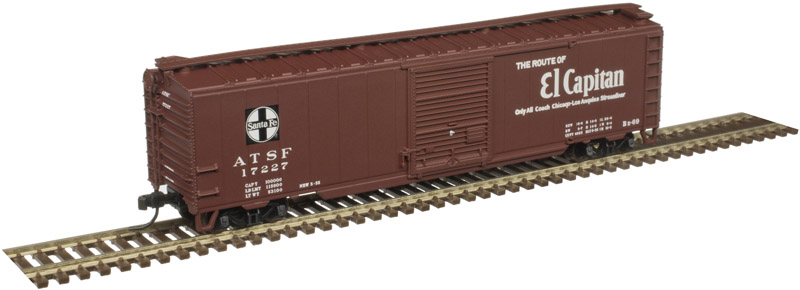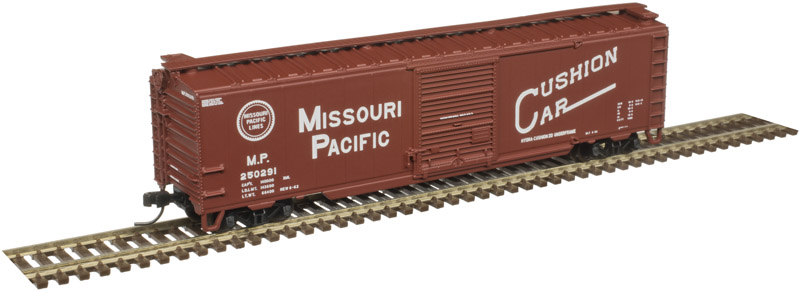Nifty Fifty-foot Boxcars by Atlas
Published: 2018-12-05 - By: CNW400
Last updated on: 2021-08-12
Last updated on: 2021-08-12
visibility: Public - Headline

#17288 "El Capitan"
The Atlas Model Railroad Co. has chosen to grow its post-war 50’ single door boxcar collection. The N-scale Trainman Line expands with six railroads represented with new paint schemes and model details. These twelve boxcars are an updated version of the rolling stock released by Atlas ten years ago in 2008. The models have the proper prototype characteristics utilized during the 1950s - 1960s. The 50’ boxcar became a standard freight car and one of the most common rolling stock we see crisscrossing the country still today.

My review includes observations of the American Car & Foundry built for Atchison, Topeka & Santa Fe (ATSF) #17288 “El Capitan” (one of 500 built in 1955) and the Missouri Pacific #250291 “Cushion Car” built in 1962.
Prototype History
After Word War II, the railroad companies began to replace their aging cars and upgrade their fleet of rolling stock. Steel became more readily available and the preferred material for the construction of these new cars. At the same time, shippers began to look for specialized cars and ways to ship more freight. Longer boxcars (50 foot) were becoming more common and weight capacities were increasing. Furthermore, technology was developed for boxcars with cushion underframes (Shock Control or Cushion Cars) to improve ride-quality and reduce the chance of damaged freight. The Pullman Company and American Car & Foundry Company (ACF) were two of the more productive builders in this era.
During the 1950s, there were continuous changes in design as the 50-foot boxcar became more common. Atlas used the primary features that portray prototypical design characteristics used during this timeframe. Some of these specifications include:
- 16-panel sides with 8-8 single-door arrangements
- improved dreadnaught ends
- Youngstown steel doors
- diagonal roof panels
Road Names and Pricing
Atlas recently introduced new paint schemes into their 50-foot Trainman series. The railroads represented in this collection include:
- Atchison, Topeka & Santa Fe (“El Capitan”)
- Atlantic Coast Line (black with “Another Cushioned Load”)
- Boston & Maine (blue & black)
- Central of Georgia (black with silver oval “The Right Way”)
- Missouri Pacific (“Cushion Car”)
- Pacific Railroad (green & yellow)
Two different road numbers are assigned for each railroad.
The suggested retail price is $24.95. An undecorated model is also available with a MSRP of $16.95.
Crisp Paint, Sharp Details -- Forgive the Error
The boxcars are packaged in the familiar clear jewel cases with a plastic sleeve to prevent scuffmarks.
The paint job is crisp and even along the entire model. The body and details are all the same color. Lettering is sharp and clear, although some magnification is needed for the smaller printing. But those small characters are neat and legible. The placement and size of all printing is very similar to that found on prototype images. According to my research, the ATSF boxcar should display the “El Capitan” logo on one side and “Ship and Travel Santa Fe All the Way” on the other (Railmodel Journal November 1998, page 18). This is not present on this Atlas model.
All of the detail pieces are molded onto the model with no additional pieces in the case. The ends feature a brake wheel and ladders. They also include the 4-4 Improved Dreadnaught ends with proper lettering. The underside has all the basic molded details such as the brake cylinder, braking system components, stringers and cross bearers.
The sides feature 9’ Youngstown steel doors, ladders, grab irons and stirrup steps (which are a little chunky in my opinion). The doors do not open and close. They also have the proper 16-panel side configuration common for single door cars. The top has a one-piece platform and diagonal roof panels.
Finally, the boxcars have Accumate truck-mounted couplers and plastic wheel sets with 50-ton friction bearing Bettendorf-style trucks. Some may prefer the alternative body-mounted coupler for a more realistic appearance or a belief that body-mounted couplers perform better while reversing a long string of cars around curves and/or turnouts. While new to the hobby, I still prefer the truck-mounted couplers for operations and way they handle tight curves on the track.
Solid Performance -- Missing the Clickety-Clack
Both cars weighed 0.7 oz., which is about a half of ounce lighter than NMRA recommendations but both tracked well during testing with no derailment problems or turn-out issues. I will add weight in the future to avoid any potential issues and refine operations of the boxcar. All couplers were measured to proper height. I tested these cars on Kato Unitrack with their plastic wheels but will probably change to metal wheel sets in the future. I hold the belief that metal wheels optimize the performance of the rolling stock and help keep a cleaner track. I am also a sucker for the ‘clickety-clack’ sound metal wheels make while zipping along my layout.
Summary
These Atlas 50’ boxcars would make a fine addition to many layouts. Even though the Trainman Line is a budget-friendly option, these models are a quality product for those that don’t need every rivet or detail. These are well-built, good-looking models that are mostly true to their prototype. They may need a little ‘tweaking’ for some people's taste: switching to Micro-Trains Line (MTL) couplers - believed by many to be the best coupler on the market; changing to metal wheels for realism and performance; and adding weight to simulate more prototypical operation and reduce possible derailment issues.
I would highly recommend these cars based on my observations.
Here is a link to the Atlas 50 foot single door boxcars listed on TroveStar.

